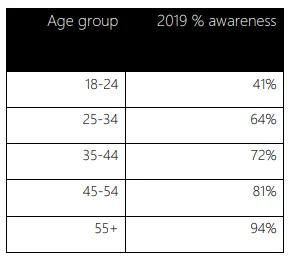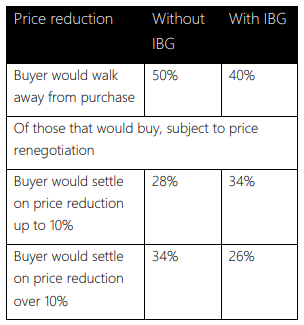In conjunction with YouGov PLC we’ve monitored consumer perceptions relating to Japanese knotweed over the last three years. Here we highlight some interesting trends. General awareness is on the increase, with 75% of respondents being aware of the plant in 2017 rising to 78% in 2019. Interestingly awareness increases with age, so maybe it is true, with age comes wisdom!  Awareness also increases in those regions of Britain most affected. Environet’s distribution heatmap “Exposed” shows Wales most affected, with a corresponding 92% awareness, followed by England (78%), then Scotland (67%). In 2018 there was landmark legal judgment in the Court of Appeal in the case Waistell & Williams v Network Rail. This has led to many new claims being brought against land and property owners that allow knotweed to spread into adjoining properties. These claims seek recovery of costs for treatment and diminution to the property’s value. Our research in 2019 asked respondents aware of Japanese knotweed how much less they would pay for a property worth £250k, if they found out it was affected by Japanese knotweed. 50% of respondents said they simply would not buy an affected property. For those that would, 28% would negotiate a price reduction of 10% or less, 34% would look for a greater reduction, 33% did not know And as the table below shows, it seems that treatment with an insurance backed guarantee (IBG) alleviates some of the angst.
Ultimately the diminution is what would be agreed between a “willing buyer and a willing seller”, but the above does show the effect of knotweed on property value, particularly in a “buyers’ market”.
Awareness also increases in those regions of Britain most affected. Environet’s distribution heatmap “Exposed” shows Wales most affected, with a corresponding 92% awareness, followed by England (78%), then Scotland (67%). In 2018 there was landmark legal judgment in the Court of Appeal in the case Waistell & Williams v Network Rail. This has led to many new claims being brought against land and property owners that allow knotweed to spread into adjoining properties. These claims seek recovery of costs for treatment and diminution to the property’s value. Our research in 2019 asked respondents aware of Japanese knotweed how much less they would pay for a property worth £250k, if they found out it was affected by Japanese knotweed. 50% of respondents said they simply would not buy an affected property. For those that would, 28% would negotiate a price reduction of 10% or less, 34% would look for a greater reduction, 33% did not know And as the table below shows, it seems that treatment with an insurance backed guarantee (IBG) alleviates some of the angst.
Ultimately the diminution is what would be agreed between a “willing buyer and a willing seller”, but the above does show the effect of knotweed on property value, particularly in a “buyers’ market”.
 Previous research by Environet has concluded that some 5% of all UK properties are affected by knotweed, either directly, or indirectly i.e. on neighbouring property. Our 2019 research reconfirms that figure, with 2% of respondents aware of knotweed admitting to currently living in property infested with knotweed and a further 3% stated that it was present, or had been present, on adjoining property(s).
Beware, affected homeowners are increasingly aware of the legal redress available to them where knotweed is not disclosed by a seller, where it is not spotted by a surveyor during a survey, and where it encroaches from one property to another. In a recent case a homeowner won damages from a chartered surveying firm for professional negligence for failing to identify and report the presence of Japanese knotweed on a RICS residential property survey. We can confidently predict we’ll be seeing more of these types of cases.
Previous research by Environet has concluded that some 5% of all UK properties are affected by knotweed, either directly, or indirectly i.e. on neighbouring property. Our 2019 research reconfirms that figure, with 2% of respondents aware of knotweed admitting to currently living in property infested with knotweed and a further 3% stated that it was present, or had been present, on adjoining property(s).
Beware, affected homeowners are increasingly aware of the legal redress available to them where knotweed is not disclosed by a seller, where it is not spotted by a surveyor during a survey, and where it encroaches from one property to another. In a recent case a homeowner won damages from a chartered surveying firm for professional negligence for failing to identify and report the presence of Japanese knotweed on a RICS residential property survey. We can confidently predict we’ll be seeing more of these types of cases.
 Awareness also increases in those regions of Britain most affected. Environet’s distribution heatmap “Exposed” shows Wales most affected, with a corresponding 92% awareness, followed by England (78%), then Scotland (67%). In 2018 there was landmark legal judgment in the Court of Appeal in the case Waistell & Williams v Network Rail. This has led to many new claims being brought against land and property owners that allow knotweed to spread into adjoining properties. These claims seek recovery of costs for treatment and diminution to the property’s value. Our research in 2019 asked respondents aware of Japanese knotweed how much less they would pay for a property worth £250k, if they found out it was affected by Japanese knotweed. 50% of respondents said they simply would not buy an affected property. For those that would, 28% would negotiate a price reduction of 10% or less, 34% would look for a greater reduction, 33% did not know And as the table below shows, it seems that treatment with an insurance backed guarantee (IBG) alleviates some of the angst.
Ultimately the diminution is what would be agreed between a “willing buyer and a willing seller”, but the above does show the effect of knotweed on property value, particularly in a “buyers’ market”.
Awareness also increases in those regions of Britain most affected. Environet’s distribution heatmap “Exposed” shows Wales most affected, with a corresponding 92% awareness, followed by England (78%), then Scotland (67%). In 2018 there was landmark legal judgment in the Court of Appeal in the case Waistell & Williams v Network Rail. This has led to many new claims being brought against land and property owners that allow knotweed to spread into adjoining properties. These claims seek recovery of costs for treatment and diminution to the property’s value. Our research in 2019 asked respondents aware of Japanese knotweed how much less they would pay for a property worth £250k, if they found out it was affected by Japanese knotweed. 50% of respondents said they simply would not buy an affected property. For those that would, 28% would negotiate a price reduction of 10% or less, 34% would look for a greater reduction, 33% did not know And as the table below shows, it seems that treatment with an insurance backed guarantee (IBG) alleviates some of the angst.
Ultimately the diminution is what would be agreed between a “willing buyer and a willing seller”, but the above does show the effect of knotweed on property value, particularly in a “buyers’ market”.
 Previous research by Environet has concluded that some 5% of all UK properties are affected by knotweed, either directly, or indirectly i.e. on neighbouring property. Our 2019 research reconfirms that figure, with 2% of respondents aware of knotweed admitting to currently living in property infested with knotweed and a further 3% stated that it was present, or had been present, on adjoining property(s).
Beware, affected homeowners are increasingly aware of the legal redress available to them where knotweed is not disclosed by a seller, where it is not spotted by a surveyor during a survey, and where it encroaches from one property to another. In a recent case a homeowner won damages from a chartered surveying firm for professional negligence for failing to identify and report the presence of Japanese knotweed on a RICS residential property survey. We can confidently predict we’ll be seeing more of these types of cases.
Previous research by Environet has concluded that some 5% of all UK properties are affected by knotweed, either directly, or indirectly i.e. on neighbouring property. Our 2019 research reconfirms that figure, with 2% of respondents aware of knotweed admitting to currently living in property infested with knotweed and a further 3% stated that it was present, or had been present, on adjoining property(s).
Beware, affected homeowners are increasingly aware of the legal redress available to them where knotweed is not disclosed by a seller, where it is not spotted by a surveyor during a survey, and where it encroaches from one property to another. In a recent case a homeowner won damages from a chartered surveying firm for professional negligence for failing to identify and report the presence of Japanese knotweed on a RICS residential property survey. We can confidently predict we’ll be seeing more of these types of cases. 


